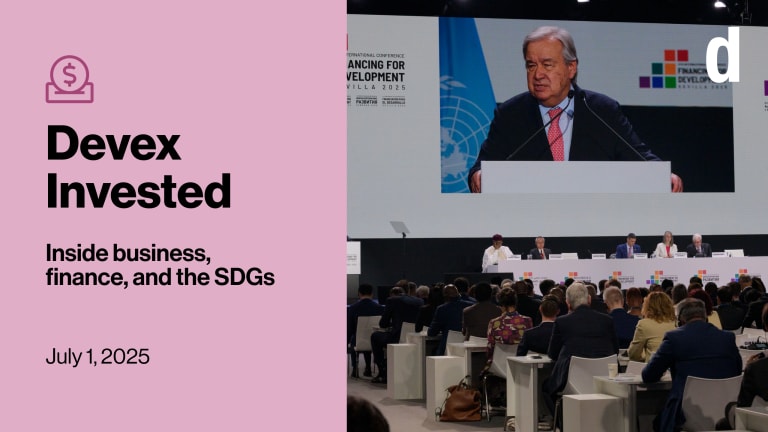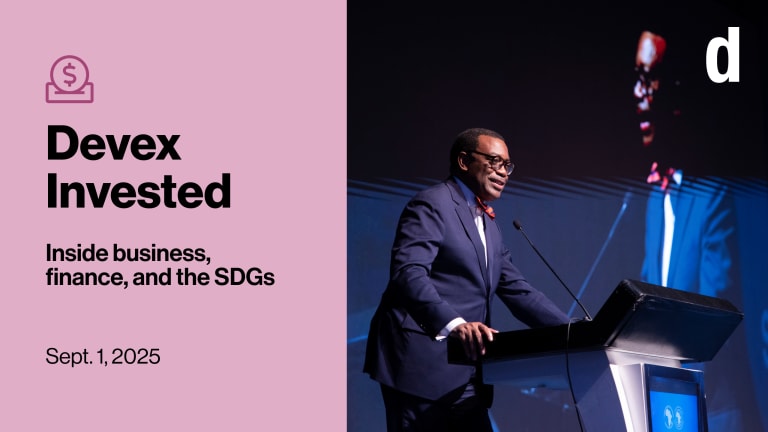
The latest Aid Transparency Index is out, and while some development institutions are crowing, others are more sheepish.
The index ranks how the major players are measuring up against the voluntary International Aid Transparency Initiative Standard, which is designed to facilitate reporting of who is doing what and where — thus improving accountability and avoiding duplication.
Best in class:
This is a preview of Devex Invested
Sign up to this weekly newsletter to get the insider brief on business, finance, and the SDGs in your inbox every Tuesday.
• The African Development Bank held onto top spot for the third year in a row.
• The Inter-American Development Bank went from third to second, noting that it reports monthly on the roughly 1,800 guaranteed loan operations it has approved since 2004.
• The European Commission’s development department entered the top 10 for the first time, with its top official, Jutta Urpilainen, saying that “accountability and transparency are crucial to the legitimacy of our work,” including its Global Gateway investment strategy — though its critics in the European Parliament may beg to differ!
Work to do:
• Australia ranked 48 out of 50 (down from 41 out of 50 in 2022), drawing criticism in local media. Minister for the Pacific and International Development Pat Conroy told Devex by email that the blame lay with the previous conservative government and that new investments in data analytics should see Australia’s ranking rise in the coming years.
• The European Investment Bank ranked only “fair” for both its sovereign and nonsovereign lending. An EIB spokesperson told Devex that’s already an improvement on the bank’s “poor” rating in 2014 and it is committed to the highest level of transparency possible. We asked EIB’s new president, Nadia Calviño, recently about transparency (at the 48-minute mark here), and she said, “If we would be making public every negotiation that is going on, and then the negotiation fails, that could have a very [harmful] impact on the client.”
• The Chinese International Development Cooperation Agency ranked last and “very poor,” with the index noting that most information came from secondhand sources as CIDCA is not an IATI member.
Read: The world’s donors are more transparent than before, new index shows (Pro)
+ A Devex Pro membership lets you access all our exclusive reporting and analyses, members-only events, and the world’s largest development job board. Not yet gone Pro? Start your 15-day free trial today.
Chinese whispers
The head of the OECD Development Assistance Committee, Carsten Staur, said in an interview earlier this month that he wanted to talk more with China (which is not a DAC member) about what it is doing on aid.
“I think that what characterizes the DAC is a high degree of transparency, a high degree of openness basically on what we are doing and how we are doing it,” Staur said. “I would hope that other providers, including China, would be as transparent on what they are doing and have maybe a bit more transparency on what is concessional aid and what is commercial loans, and where are their activities and how do they actually engage, what kind of strategies do they really want to work on … I am really open to that kind of discussion."
All we would add is that our experience (and that of many NGOs) after years of trying to follow the deliberations of the DAC itself, which meets in secret and does not announce anything until it has reached consensus among its 32 members, is not one of a “high degree of transparency.”
Related reading: What if all DAC meetings were public? (Pro)
Now see here
Speaking of transparency, we enjoyed this wonderfully clear map of development finance flows to Southeast Asia, released last month, by Australia’s Lowy Institute think tank.
Drawing on over 120,000 projects from 107 development partners across 11 countries, the findings include:
• Total development finance (including official development assistance and semi- or nonconcessional loans) to the region saw a pandemic-inspired surge in 2020, but has since been on the decline.
• Chinese development finance to the region hit its lowest level in eight years in 2022.
• Climate-related finance has eaten into rather than come on top of existing development support.
And beware the taxonomy trap. The leading climate-related donors for 2015-2022 were Japan, the Asian Development Bank, China, and the World Bank. However, the researchers found that China is the leading provider of financing where addressing climate change is the principal objective.
Read: What’s behind Southeast Asia’s dwindling development finance (Pro)
ICYMI: What the world could learn from Asia's experience with climate finance (Pro)
Risk and reward
Your next job?
Director, Gender, Women and Civil Society
African Development Bank
Côte d'Ivoire
Earlier this month we brought you an exclusive look at a draft of the Brazilian G20’s road map for reforming the world’s multilateral development banks. The final document is due for discussion in September.
Meanwhile, we were talking with an Invested reader last week who argued that absent a capital increase or change to the MDBs’ credit ratings, it was hard to see how they were taking on more risk.
We put that question to Annalisa Prizzon, principal research fellow at the ODI global affairs think tank, who has been working closely on MDB reform.
“Operational and financial risks are separate — and both have their part to play in unsticking the boldness element of the MDB reform agenda,” Prizzon wrote back.
“At the operational level, as the [Independent Expert Group] report argued last year, to streamline their operations, MDBs should consistently and more widely apply a risk-based approach to project and program approvals, with certain decisions delegated to management (low-risk and below a certain amount) and greater use of country systems where these are adequate and strong enough. Measures have been implemented in individual MDBs and across the system. But progress will take a while to materialise.
“At the financial level, there are a number of measures where MDBs can better manage risk and free up capital. Here there is some progress. For example, these measures include using donor guarantees at the portfolio level to take risk off balance sheets - most MDBs are implementing it - and leveraging on shareholder-defined risk appetites rather than being influenced by credit rating agencies,” she wrote.
What’s your take? Get in touch at vince.chadwick@devex.com.
+ You can also catch up on our coverage of MDB reforms.
Invested is taking a break next week and will be back on Tuesday, Aug. 13. In the meantime, Devex will be sending daily deep dives into global health, food and agriculture, and finance. Sign up to our daily Newswire to get them in your inbox.
What we’re reading
U.K. Energy Secretary Ed Miliband says Labour will honor pledge of £11.6 billion in overseas climate aid. [The Guardian]
IMF approves $3.4 billion funding program for Ethiopia. [Bloomberg]
World Bank taps global law firm to review Bridge sex abuse investigation. [Devex]








